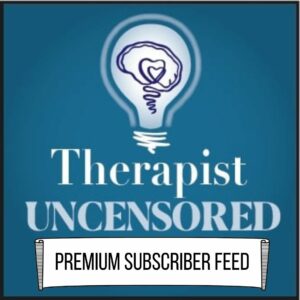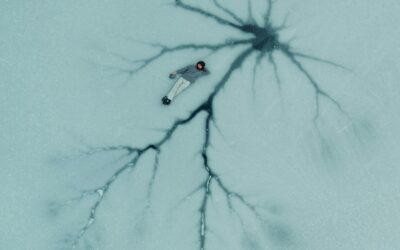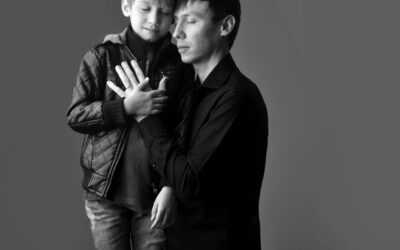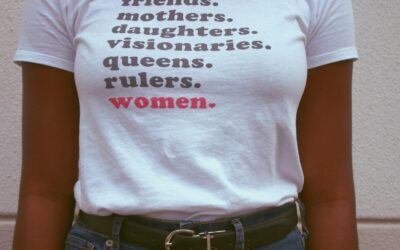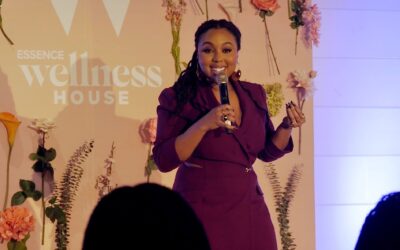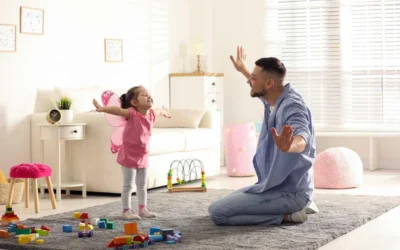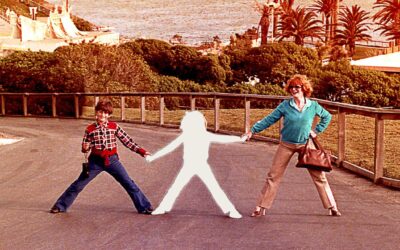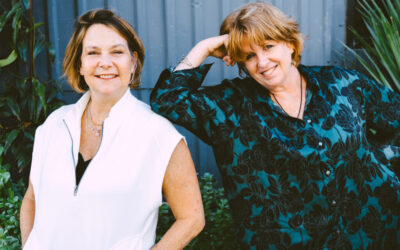Podcast: Play in new window | Download (Duration: 1:18:19 — 53.8MB)
Subscribe: Apple Podcasts | Spotify | Amazon Music
Using neuroanatomy and her experience having a massive stroke that took her self-conscious mind, Dr. Jill Bolte-Taylor and Sue Marriott discuss the 4 skill subsets in the brain that help us relate to ourselves and the world. Her TED Talk was the first one to ever go viral and has been viewed now 27 million times, so her ideas are clearly inspiring. Her new work brings together psychology, neurobiology and spiritual awakening.
NOTE Dec, 2021: We will be releasing deeper dive episodes of Jill Bolte-Taylor's work and explore Whole Brain Living together on our private feed (only $5/mo). In addition, once we get through the book, we will have a live discussion all together in Jan, 2022. Join us by clicking the image to the right or go to www.therapistuncensored.com/join
Dr. Jill Bolte Taylor is a Harvard-trained neuroanatomist who suffered a stroke that led her on a path to rediscovering her brain. Her viral TED Talk, “My stroke of insight,” was the inspiration for her first book, My Stroke of Insight: A Brain Scientist's Personal Journey. Now she's back to offer a deeper insight into the inner workings of the mind with her latest book, Whole Brain Living: The Anatomy of Choice and the Four Characters That Drive Our Life. In this episode, she dives deep into how the four distinct parts of our brain dictate how we live and be in the world. She gives great insight on how we can create anatomy by truly getting to know these four characters and owning our power. Tune in for this interesting and eye-opening discussion that could change the way you live your life.
Show Notes:
00:00:00 Introduction
00:03:30 The Beginnings Of Dr. Jill Bolte Taylor
00:06:18 On her viral TedTalk
00:08:17 What science can’t explain
00:10:10 Left hemisphere vs right hemisphere
00:14:51 From My Stroke of Insight To Whole Brain Living, the individual in the left brain vs the individual in the right brain
00:19:40 The Four Characters: Character 1(top-left) & 2(left lower limbic)
00:31:38 How your brain can change the narrative
00:36:00 Regulation in the limbic system
00:40:53 The Four Characters: Character 3(right lower limbic) & 4(top-right)
00:50:08 The BRAIN Huddle and our personal power to choose how we want to be
01:00:40 What’s next for Dr. Jill
01:02:27 The harmony of all Characters as the evolution of humanity
01:04:08 How to contact Dr. Jill
01:06:41 Psychedelics and connection with the planet
01:09:50 More on how to contact Dr. Jill
Hear more psychology and neuroscience in previous episodes:
Episode 93 Polyvagal Theory with Dr. Stephen Porges
Episode 110 Story Follows State (more polyvagal theory) with Deb Dana
Episode 117 Resilience Trauma and the Brain with Dr. Bruce Perry
—
Listen to the podcast here:
Whole Brain Living – Psychology + Neuroanatomy + Spirit with Dr. Jill Bolte-Taylor
Transcript:
Ann Kelley:
You are going to be blown away by this episode with Jill Bolte Taylor. We didn't find out until after the interview that Oprah Winfrey named her as one of her all-time favorite guests and you're going to see why. This episode is a conversational mix of fascinating life stories, insights about neuroanatomy and psychology and good inspiration.
Jill Bolte Taylor is a Harvard-trained neuroanatomist who started her career researching the brain and mental illness but she suffered a stroke on the left hemisphere of her brain. Through her experience of the stroke itself and her recovery, she continues to bring some of the most amazing insights regarding brain function and Whole Brain Living: The Anatomy of Choice and the Four Characters That Drive Our Life.
Her TED Talk was the very first one to go viral, I believe, with almost 28 million views. In this episode, my cohost, Sue Marriott, explores her thoughts on what made her message take off and what she was tapping into that people needed. After her first book called My Stroke of Insight: A Brain Scientist's Personal Journey, she was awarded Time Magazine's 100 Most Influential People in the World.
When we got ahold of her new book, Whole Brain Living, we knew it was exactly the material our readers would want. We are thrilled she accepted Sue's invitation to come to the show. We're going to be organizing a Therapist Uncensored reading pod for this new book for our supporters, our Neuronerd community.
We will try at some point to put together something for the public on how to apply this material but we're going to start with our Neuronerd community. This is a great time to jump in and become a show supporter if you haven't already because not only will you get things like this reading pod as well as an ad-free podcast. Most importantly, hopefully, you're also going to be helping Sue and I produce this great content for you and many across the globe who might not otherwise be able to run into it. If you can, we would appreciate it. Join us at www.TherapistUncensored.com/join. Without further ado, let's jump in with my cohost, Sue Marriott and Dr. Jill Bolte Taylor.
—
Welcome, Jill. I'm so delighted to have you with us.
Thank you, Sue. I'm happy to be here.
An audience of our show brought you to my attention. I had seen your work a while back but the exciting thing was she had brought your new book to my attention. I read it and it is incredible. There's so much practical and real-life sense in it that I immediately wanted to bring you on and let us share this with everybody because anybody anywhere reading this is going to benefit from your thoughts.
Thank you. I feel that way. Anybody who's got a brain, the better we know. It's an owner's manual. How are you anatomically organized? What can you know about that? How can you differentiate those different parts, use them and recognize them in other people?
You make it simple and straightforward. We're going to get into that in detail because I want people to walk away from this show understanding these ideas. We can take half a step back and share a little bit about your journey and how you got here, picking up wherever you would like as far as what you would like us to know about you.
I became fascinated with the brain as a little girl because my brother was only eighteen months older than me. We would have the same situation and walk away with very different interpretations about what happened. For example, if we were playing near the street and our mom G.G. would come running out screaming, he thought she was angry. I thought she was scared for us. It's how we interpret the experience at the level of the brain.
Eventually, I grew up to study the brain and he grew up to be diagnosed with schizophrenia. I was fascinated with how does our brain creates our perception of reality. What is reality? At a cellular level, how is it that my brother's brain is organized and wired differently than my brain so I can connect my dreams to my reality but he could not. He ended up experiencing delusions. I was teaching and performing research at Harvard Medical School and studying which cells communicate with which cells with which chemicals and what quantities of those chemicals in which portions of the brain.
I woke up one day at the age of 37 and I was experiencing a major hemorrhage in the left half of my brain. Over the course of four hours, I watched my brain completely deteriorate in its ability to process information about the external world. My right hemisphere was still onlin
e but the left hemisphere completely disappeared. On the morning of the stroke, I could not walk, talk, read, write or recall any of my life. I was an invalid in a woman's body and I gave a TED Talk. If your readers recognize the story, it has 28 million views. It was the first TED Talk to ever go viral.
The fundamental difference between having a right brain and a left brain is the right brain is in the present moment. The left brain comes online and defines with a holographic image of me, the individual.
Do you have a sense of why that is? What was speaking to people?
First of all, we were primed. There were only 5 or 6 TED Talks online in 2008 because Chris Anderson had purchased the company and changed it. He was bringing his modern guy and he was bringing it into the internet world. We were the first group in 2008. They said, “Half of you, we will post you. Half of you, don't worry if you do badly. No one will ever see it.”
My TED Talk was right at the beginning of the conference and it was the last talk in the first session. TED is about the big ideas and the big idea question was, “Who are we?” TED had heard my experience so they invited me. I came to it through the perspective of who are we inside of me because ultimately, regardless of how we're looking anthropologically or sociologically as societal humanity, who are we inside of our brain? It's to take that journey and hold the space for people to let go of their left brain, which is the identification of me, the individual or the self and to shift away from the self into the experience of all that is.
Many of us have had these experiences where we feel connected to all that is. Yet, there's that me over here and there's this internal conflict between different value structures. People resonated through their heart consciousness, which is essentially the right hemisphere and then there is the cognitive consciousness, which is the left hemisphere. Everybody could relate to it and it exploded into the world.
It makes me think of hunger that must have been there for something more that wasn't too woo-woo and mystical where we would lose a lot of people. It was a translation of the mystical into scientific terms.
We have all of these experiences that we cannot explain. It doesn't mean we're not having the experiences and they're not real. It simply means we don't have the science that is designed and structured in a way that is capable of capturing the experience and measuring the experience so that we can talk about it at the level of language and linearity, measure it and be able to duplicate it through the scientific method.
By definition, the scientific method is a method. You have to have linear thinking. That is the way the left brain processes. Science is essentially measuring the physical world that we experience through our left brain. It's not very good at being able to replicate, capture or measure these other experiences that we're having that we would often define as spiritual or woo-woo.
It makes me think of the translation and the left brain doesn't want to hear it. It's threatening to get into something that it can't understand.
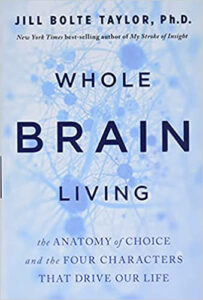
Whole Brain Living: The Anatomy of Choice and the Four Characters That Drive Our Life
It's easy to criticize, reject and push away when we don't know. The fact of the matter is there's so much that we don't know. You can go out onto the street and say, “Do you believe in global warming?” People say, “No.” It's like, “What do you know about global warming?” They will say, “Pretty much nothing.” We're inclined to make this negative judgment as to the knee-jerk response to that which we don't know or don't understand as opposed to, “Tell me more. I'm open to the possibility.”
It's for some of the folks that believe that talking about the left brain and the right brain is old school.
That's not old school. It went a little bit crazy. There's no question. If you want to know everything that we pretty much know a lot anyway about the differences between the right hemisphere and the left hemisphere, there's a magnificent book by Dr. Iain McGilchrist. He's male. Second, he's a psychiatrist and medical doctor. He's a lovely human being. He has written this tome of what do we know based on lab work over the years. It's called The Master and His Emissary: The Divided Brain and the Making of the Western World. He will take you into all the bird studies, even birds, other creatures and at the level of the molecules spiral in different orientations, based on how they're organizing information.
The people who are poo-pooing the difference between the right and the left hemisphere need to dig a little bit deeper at the data that we have. I will give them the argument that you're not just this or that. We're both. We are this combination and there are millions of circuits going on at the same time. However, the human brain can only focus on one true circuit at a time. Where is that circuit? If I'm doing my creativity then I have to release myself from the box of what is right, wrong, good and bad.
Those loops are organized in the left hemisphere. The left hemisphere is good at creating structure and order in the way that it defines right and wrong but that has to be quiet for my brain to become innovative and creative. There's no question about the way that the brain is organized. You can't come in and say, “The right brain is all about this and the left brain is all about that. You're either this or that.” We're this magical mixture but the question is, “Do I know how to capitalize on all the things going on inside of my head?” That's what my new book, Whole Brain Living is about.
How do I identify and differentiate which parts of my brain I'm embodying at any moment in time? When I understand the character profiles that are radiating from the subsets of skillsets at a neuroanatomical level then I can choose to be in that character or identify which character someone else is exhibiting. It's based on the anatomy of the brain.
I'm not coming in and saying anything new. I'm saying, “Take everything that we understand to be true, all the research that we believe to be true and all the experiential that we don't know how to measure but we know people have these experiences. Let's put it in the brain.” Look at the anatomy of the brain, create a paradigm where we can marry our psychology and what we believe to be true on personality and put that in the brain.
In Iain McGilchrist, there's also an RSA in animation that explains this very quickly. You have had the actual experience of it so it's inarguable. When people go and talk about the characters later sometimes they're going to have to deal with the pushback of it. That's too simple or something like that. It's nice to get from the horse's mouth. This is what you have to say about that. That will empower people to be able to use this.
There are Four Characters. There are two emotional characters, one in each hemisphere and two thinking character tissue or modules of cells.
Also, as you learn about the Four Characters, the part of the brain that comes out with critical hostility is a specific character inside of ourselves. Those of us who get caught up in that negative circuitry don't like being told we're being negative or this or that. The real power is being able to say to these people, “You also have these other parts of yourself.” If for some reason we get routinized in certain circuitry because that's how we interact with the world, are we truly using our whole brain?
We don't want to use our whole brain because we don't want to be miserable all the time, in pain, critical and mean all the time. We do want to rest, be at peace, get a whole bunch done and play. Wouldn't it be lovely if we could find a relationship with the love that exists in the universe that, “That's woo-woo? That's bad.” It's not. It's right there in your brain and you can find it if you're open to the possibility.
From your first book, which is My Stroke of Insight, to this book, how did that happen? Where are you with that?
Book number one was a memoir of the experience of stroke through the eyes of a scientist. I had to write that book because my mother said, “Jill, you're on the phone helping all these people, 8 to 10 hours a day and you don't have a life. You need to write this down so that you can give them the material and distribute it so anybody in need can access it.” It was like, “You're going to make me sit down and write.” I did because I had been sharing it so much with people in need that I did.
That was book number one. It's still pretty much in the Amazon marketplace. It's the number one book on stroke because it's a fascinating experience of watching your brain deteriorate through the eyes of a scientist who thinks in terms of brain circuitry. What I needed to recover is what got in the way of that recovery. The journey to book number two was that I think in terms of cells and circuits. It's how I have organized my brain and life, especially in the rebuilding of that circuitry.
To me, I lost the left brain so I lost the left rational thinking me. She was gone and I lost the pain from my past part of me and my emotional system. She died completely and had to be reborn in a new time but I had this magnificent experiential character right here of my right emotional tissue. I had this right-thinking tissue that had me connected to all that is and I was as big as the universe. The fundamental difference between having a right brain and a left brain is the right brain is in the present moment. The left brain comes online and defines with a holographic image of me, the individual. All the filtering of information for the left brain comes through the filter of me, the individual.
If people don't think there's a difference between me, the individual and know me, the individual then they have never had that experience. It doesn't mean it's not real. You can ruin a group of cells in the left parietal region, which creates a holographic image of my body, where I begin and where I end. You wipe those out and I have no perception of the self as an individual. With that comes language and with language, there's the linearity of thinking. Part of linear thinking is, “I am an individual. I am separate from the atoms and the molecules around me.”
You wipe that out. I'm sorry, ladies and gentlemen but you become a part of the whole with no distinction of self. I did not know what a mother was, much less who my mother was and this was pretty fundamental information. I have to have a left brain to create that information. I was living and breathing this concept of my two emotional systems and two thinking brains. I knew them very well because I lost two. I had to purposely use my right brain characters to set me up for success and regain the skillsets of my left emotion tissue and my left thinking tissue.
What I realized was once they came back online, they had a personality and it was a strong personality. My Character 1 rational thinking left tissue comes back on and she says, “It's great to be back. I want to take over the brain again. I want to be the boss in here.” We're all in here looking at her going, “We are so glad you're back online because we need your skillsets and we love you. Thank goodness you're back but you're not going to be the boss anymore. We're going to have a democracy inside of this head.” That's what I created. I created a tool of communication between these four very distinctive characters.
When I was giving a presentation, I was talking about how great it is to talk about the brain these days because people know the terminology. They know about the amygdala, the hippocampus and the anterior cingulate gyrus. It's all very exciting. The fact of the matter is we have 2 amygdalae, 2 hippocampi and 2 anterior cingulate gyri. There was an audible gasp in the room and I realized that was what was wrong. People think we have one emotional system. We don't. There's one in the present and one about me, my past and my future. As soon as we can differentiate those emotions, clarity comes in.
For readers of our show, people are very familiar with the different levels. You're right. It's typically discussed in terms of midbrain and prefrontal cortex as one thing. One of the things that were exciting was just even beginning to think about is that it solves the left brain problem anyway because you have both. The other thing that you did with it is you personalized it. That was so lovely. One of the ways that you work with these ideas is that you wake up and check in with everybody. I was so touched by that like, “This one is not awake yet.” It's not shaming. There's no mortality to it.
It's cells and circuits. I am all of it. We are all of it. Each of these groups of cells is communicating with us in one way or another, even that part of us that doesn't have language and has rage, unhappiness, desperation, attack, self-attack and all that. It's still the energy of communication. They're all important. There are Four Characters. There are two emotional characters, one in each hemisphere and two thinking character tissue or modules of cells.
These are actual modules of cells that perform certain subsets of ability. I encourage everybody to name your character your name because it has to be important to you. I call my Character 1. She's my rational left brain thinking tissue. That tissue is specifically designed to organize and categorize my external world so I can interact with the external world. She organizes and categorizes. She has that holographic image of me, the individual and defines me as me.
She knows my name and address. You wipe her out. She defines what is right, wrong, good and bad. She thinks hierarchically. She's materialism-based. She cares about how big the house is compared to the neighbors. She's a control freak. She controls people, places and things. Thank goodness we have a Character 1 and I call my Character 1 Helen. It's short for hell on wheels. She gets it done. Sue, what have you named your Character 1?
I was thinking of it as Taskmaster but what I realized is I had the playful names on the right side and then the more functional names on the left side. Also, I'm still learning it and I want to teach it and share it so Taskmaster was what came to mind.
That's what it is. It's the taskmaster. It's going to make and follow the to-do list. The phone is going to ring. It's going to use this tone of voice and say, “What can I do for you?”
There's a difference between the innate experience of joy, and happiness based on external circumstances.
Instead of the Golden Retriever?
Character 1 is busy. This part of ourselves is our Type A personality. It organizes our life and gets them done. Some of us have a lot more of that than others. You can walk into anybody's house, open some drawers and pretty much see. Some people alphabetize their spices. I would not be one of those people. My Helen goes and works in the office. In my office, I've got piles but I've been gone for six months so I do have an excuse. Helen is on it and she cares enough to say, “Ladies and gentlemen, I have been gone for six months. That's why my office is a mess.” Nobody else in my brain cares about that. Your brain might not care either.
That's Character 1. It's the thinking rational tissue of our left brain that specifically organizes our relationship. It's the relationship of me, the individual in relationship with the external world. I have to be organized as me, the mass in relationship with that external world. Language is important. It's going to count well and be good with mathematics and engineering because it's going to think linearly. It's going to be good mechanically because it's good at looking at pieces and putting them together. If I take this piece and stick it in there before I take that other washer and stick it in there in between, it's not going to work. It's that linearity and organization of thinking. That's Character 1.
It's top-left and the left side tends to have some of the negativity. Some of it, as you said is the comparison and those kinds of things.
It's going to compare and compete. It's me, the individual away from you. I'm now separate from you so I'm going to compete with you for that job on that hierarchy because we both want the bigger house. We want more money in our paycheck. We're going to compete and compare with one another, “What shoes are you wearing? I can make a critical judgment while I can wear a stiletto. I got 6 inches going under me.” It's all this comparison and competition.
Do you think that this is related to some of the findings that they're finding in psilocybin research and psychedelic research about being able to turn off those parts of the brain to experience something different?
That's essentially what happened to my brain. I wiped out my left brain characters. Psilocybin wipes out that left brain and brings you into the experiential of the peacefulness of the present moment.
There are so many positive findings of that. Once you experience it, you can't unexperience it. It's done. This is why a very little bit of treatment can change the course. We have top-left.
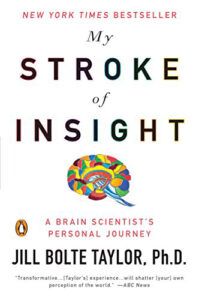
My Stroke of Insight: A Brain Scientist's Personal Journey
Think about the top-left versus the bottom-left. The top-left is the thinking analytical neocortex, the prefrontal cortex and those lovely things that will go in with that. Below that is the limbic emotional tissue of the left hemisphere, where the left hemisphere has linearity of time. It has the past, the future and me, the individual. My personal past got wiped out because that's where the hemorrhage happened. The emotion, pain, trauma and craving of my addictions from the past are all going to be right there in Character 2.
In the Character 2, there's an interesting controversy that happens about the whole happiness psychology. There's a group of people that say, “We're happy in that left emotional system.” We are happy when what is happening outside us is what we want it to be. We're not happy when what's happening outside of us is not what we want it to be. It's not just where we're happy. It's also where we're sad, mad or angry from the past. It's all our past emotional baggage. Compare that emotion to the deep inner joy of simply being alive and existing in the present moment.
Joy is more what's going on in the right brain as compared to happiness and happiness under certain circumstances. Let's say you and I are going to go for a picnic and we're both excited. It's raining outside and then little Character 2 is going, “I'm not very happy because I wanted to go for a picnic with Sue and now it's raining.” The sun shines and then now I'm happy. I can train myself to be that happy under more adaptable or flexible circumstances based on the external but inside me, I'm pretty happy anyway. I got joy going on. That is my right-brain experience.
There's a difference between the innate experience of joy and happiness based on external circumstances. I call my little Character 2 Abby. Abby is short for abandoned. I believe that the moment I came flying out of my mother's womb where I was in a symbiotic relationship with this beautiful limbic environment, I heard the drumming of my mother's heart and I was part of it all.
All of a sudden, I'm shocked by this singularity of being. I've got lights burning my brain like wildfire sound and people poking, prodding and in some cases sticking needles into me. To me, that's the moment of abandonment. Upon that circuitry, all of my pain from my childhood gets built on top of that circuitry.
We have this little unhappy, critical, potentially mean, blaming, pointing-the-finger and mad at self, “I'm not worthy. I'm not good enough. I'm craving this. I need that.” All of that is inside of us inside of that little Character 2. The value of the Character 2 is those cells at the level of the reptilian brain, which is essentially our midbrain. We have that new added-on mammalian tissue of the limbic tissue, one on each side, which is going to be fight or flight in the present moment in the right and the experience from the past or fear of the future in that left.
The beauty of the Character 2 is information has streamed in and gone immediately into both of those amygdalae. The amygdala of the left hemisphere emotional tissue immediately takes what is in the present moment and says, “Have I ever experienced this before? Is there a reason why I should push it away and say no?” That's amazing. The cells themselves are jumping out of the present moment experience because the present moment experience is a level of consciousness.
These cells are willing to step out of that blissful and peaceful euphoria of the present experience and say, “Have I ever experienced or seen something like that before?” For example, I'm 60 years old and I see a dog. I remember when I was ten years old, I was riding a bike and a dog that looked like that was nipping at my feet and trying to bite me. For the next 50 years, every time I see a dog like that, that amygdala goes alert, “I don't feel safe because I have seen that dog before and that dog's not safe. I need to push it away.”
The breath is something that we can immediately bring our minds to in the present moment to stabilize ourselves in the body in relationship with these limbic cells.
It's amazing and because the Character 1 tissue is developed above and on top of Character 2 then Character 1 is designed to refine the experience of what's going on with Character 2. That's what's going on in the left hemisphere. The left hemisphere is not in the present moment. It's about me, the individual. It has the past and future because it is programmed at the level of those cells as they're taking the exit and going into that limbic system at the left brain to step out of the consciousness of the present moment.
One of the things I love about what you're saying is this doesn't have to be trauma. Everybody has this birth experience and lower-left limbic that has the raw feeling. The brain, the top part, comes up and makes a story. You didn't say that exactly this way but there's a story about why they're feeling that way. Is that right?
You're right.
We talk a lot about our narrative. What is our narrative? Can we update and change our narrative and therapy?
You said a lower-left limbic. I like that. That's for all right there, the three Ls. The lower-left limbic is dysregulation and an alarm alert, “I don't feel safe.” I can become dysregulated from my normal neurological happy functioning self. When I move into the alarm alert, I don't feel safe. I have anxiety and fear. I need to go and push away. We're biologically programmed to save our lives. We have this thinking tissue that comes in as a human being. The portion of our brains that are separate from other mammals is the neocortex. That's to find and create in the left brain me, the individual and language.
I can create the story and take the energy of, “I don't feel safe,” and weave in that left brain the story. Do we have the power to change that narrative? Absolutely. We just made it all up based on a piece of data. It's genius at what it does. Each of these groups of cells is genius at what they do. It doesn't mean they're right. It just means they're a genius and good at what they're designed to do.
They're taking care of us. For our readers, we talk a lot about attachment. The attachment system is that you first have the biological experience. Then that gets encoded in neural grooves. I call it neural grooves. You've got the freeway of this is what's happening. The internal working model is the story that gets laid on that, “People are safe. People are not safe. I'm worthy. I'm unworthy. People are going to let me down.” It's those sorts of things.
Those cells in that left brain are attracted toward that which feels familiar. Safe is defined by that group of cells as, “Does it feel familiar?” If it feels familiar then it's safe. Let's say I'm looking at a person. I have blonde hair and blue eyes. If someone with black hair and black eyes comes in, they represent a different religion that I'm not familiar with or if they're a different race than I am then I am programmed at that level to push away and say, “That's not familiar to me. Those smells of curry and different aromas, I have never had those before.” That's a push away. Our whole racism system is at a biological level but can we train these and use our whole brain to say, “I want to go toward that instead of push away from that.”
One of our taglines is, “It's not me. It's my medulla.” It's the same thing. It's like, “That's my reaction to something novel. It's not true and it's not that I'm bad that I have a fear reaction.”
We need that. It's designed to save our lives a million times in our lifetime. It's not bad. None of these systems is bad. The question is, “How do you want to live your life?” Do you want to live your life, always feeling that fear and push away or do you want to recognize I'm feeling anxious? There's something out there that doesn't feel familiar so it doesn't feel safe. Character 1 can come on, make the assessment and say, “Do I need to fix something or rearrange something?” It's all about fixing and controlling for you to be able to relax so that you can at that dinner party go toward that person who is different from you instead of cuddling over here on the corner with other people who are like you.
That should be your next book. It's the cultural and social implications of this. Can I ask a more detailed question if you don't mind? I'm excited to get to the right side because that's the fun part. Are you familiar with Stephen Porges and The Polyvagal Theory: Neurophysiological Foundations of Emotions, Attachment, Communication and Self-regulation?
Absolutely. He mentioned Bloomington there.
We love him. I have had both him and his wife talking about oxytocin and all of that. Our audience is very interested in that kind of thing. There's the regulation, upregulation or downregulation. Are we still talking about that happening on the left side of the lower-left? Is that both the right and left? I'm thinking of the limbic part and the defensive reaction whether we upregulate or downregulate. What I'm thinking, based on what you're saying is that how you dysregulate is a detail within the left side or the left limbic. Is that right?
I haven't explored his wiring maps. I would have to do that. I do know that more than 70% of the fibers are coming up from the body to the brain instead of down. If we want to self-regulate in Characters 2 and 3, the limbic system is going into the body, using the body and wiring ourselves up, which is why for the BRAIN Huddle, the very first step is the breath. The breath is something that we can immediately bring our minds to in the present moment to stabilize ourselves in the body in relationship with these limbic cells. The entire stress circuit is what's going on in the left brain in relationship to Character 1 and Character 2 going up and down. I haven't had my head in his book for a long time. I will go back and look at that.
I think of it as the Toddler. There's the Taskmaster and then the bottom-left is a little toddler. I'm not sure if that fits but at the moment, dysregulation and seize the problem.
The thing about the limbic cells is they never mature. Our little unhappy and wounded self from our past never matures. They're different ages depending on where our traumas come in and when we stopped being heard. For some of us, it's as infants. For some of us, we were little toddlers, 5 or 6 or teenagers. It never gets past that. For the right brain, we'll get there.
The BRAIN Huddle: Breathe, Recognize, Appreciate, Inquire, Navigate
I want everyone to know what you said, which is they never grow up. It's going to be that way. When you are doing therapy and a lot of work and you dysregulate again or regress into some of these behaviors, it's not that you're doing anything wrong. It's simply that in this case, the whole brain has broken through and there are things to do about that. Certainly, it's beating yourself up that, “I thought I dealt with that.” It's all of those sorts of things.
We don't want to deal with it and we don't want to make it go away. This is why, especially that Character 2. Character 2 takes the present moment, takes it into the past and says, “Have I ever seen this before? Give me a reason to push away.” It's because of those cells that we have the potential for growth. That's our growth edge. I know if I have an alarm alert that is based on my history, that's where I'm stuck. That's my growth edge. I can either try to deny it, push it down, go off into my Character 1 and rationalize my way around it or go into my Characters 3 or 4 and escape it all together into the present moment.
That's the pipe and the pipe is now getting stuffed with something in there. I need to get it unplugged. Blow out the Drano, pull that out and examine what is that bias inside of my perception that gives me this negative impact physiologically into my body. The thing about when the amygdala goes on alarm alert, our normal safe selves, which is what we want to neural regulate ourselves to. We have been stripped of that.
We want to go back to that peaceful neural regulation of self because otherwise, that's going to be a disturbance inside of ourselves physiologically. It's going to be stimulating that stress circuitry on top of it. That's when the cells in our body are going and that's when we get sick. If we're living in that stress and that of normal and healthy regulation, the whole body is on alarm alert.
The brain is brilliant. The way you're describing it is how smart that lower-left is. This is not something we want to cut out of ourselves like a bruise on an apple. This is integral and very much part of things. I love you calling it the growing edge but with enough safety only. Let's pop right and talk about safety and being able to manage.
As we're thinking about them, we got Character 1 in left thinking and high thinking and Character 2 in the lower-left limbic. Character 3 is going to be right-lower limbic and then Character 4 will be right thinking. It's the neocortex of that right hemisphere. With the right hemisphere, the biggest difference is I don't exist as an individual anymore. That's all about me. All my details are in the left hemisphere. Wipe out the left hemisphere. I experienced myself to be big as the universe. That was the gift of the stroke that I experienced.
I completely wiped out me, the individual and existed in an absolute quiet brain for five full weeks. It was two and a half weeks before I had surgery after the hemorrhage and then two and a half weeks after. There's language as the brain begins to recover. I could start hooking back into different circuits in that left brain because the blood clot that was the size of a fist in the beginning and then the size of a golf ball by surgery, once they took that pressure off then it could start to begin again. It was like tuning in to a radio that started as static.
In the absence of that, I had no identity and definition of individuality. I was as big as the universe. The left hemisphere wasn't there to participate. I was connected to all that is and I felt enormous and expansive. All I felt was this incredible experience of love. I was so happy. I would be sitting on a couch drooling and completely wounded. My mother would look at me and she would say, “Why are you so happy?” I look at her and I smile because I was in such awe that this organic thing and collection of 50 trillion cells were alive.
I could experience a light coming in from the external. I could hear sound. I couldn't make any sense out of any of it but I was this machine that was alive. I was so caught up in the awe that I would weep. People say, “When people have left brain damage, they cry all the time. They're unhappy and miserable.” That's a misinterpretation of data. We are in such awe that we exist and all the miracle of life makes us weep. It's amazing.
I know that there are people resonating with you around that meditate, spirituality and all of these things. I want to keep the thread of this more social piece. I love what you said about the person, the smells and things like that. If they put their forehead to the ground to pray, that's foreign and scary. We don't have mirror neurons versus if you hear hymns or something that you have been raised with, immediately you signal safety and even inappropriately like, “We're together here because we're not discerning.” There's the bottom-right.
The right limbic emotion is experiential. There's an amygdala there, a hippocampus and an anterior cingulate gyrus. We have half the limbic system right there in the right hemisphere as we did in the left. The right hemisphere doesn't have me, the individual. It has the experience of the present moment. What is the experience of the air? How much humidity do I feel in the air? What's the temperature of the air? How does it feel to have these glasses on my face? What does it feel like to have the clothing on my body? It's the energies around me, to have the warmth of the dog on my lap and the experience of the present moment.
This is the part of us that is alive. It's alert and in the present moment. It doesn't have right, wrong, good or bad. It's creative and open to possibility. It doesn't have me, the individual. It's communal and, “I want to play with you, do things with you, get lost playing music with you, do art with you and go out into the woods and explore with you.” It's an adrenaline junkie. It's like, “Sue, let's go parachuting, hang gliding or do this.” It's also the part of us that at this moment come up with a bad idea, “Let's go pick a fight, do this or do that.”
A lot of Character 3s end up in jail because they weren't thinking, “What were you thinking?” “I wasn't thinking. I was experiential. I was swept away by the experience.” I call my Character 3 Pigpen because of the little character in Charles Shultz's Peanuts. Pigpen was walking around in a dust storm and he's good. In his dust storm, he's like, “I could have dust from Babylonia in me. Isn't that exciting?” It's all the possibilities. We're playful, creative and innovative. That's that experiential tissue.
The thinking tissue that's added on as the human being is the neocortex of the right hemisphere. It's not about me, the individual. It's about my connection to all that is, including the consciousness of the cells of my body. When we learn new things, the stress circuitry of the left brain is dominant. There's the relationship between the right hemisphere, the heart consciousness, the gut consciousness and the intuition. What is intuition? It's our ability to experience information on a bigger plane and make decisions based on that pattern response as opposed to the details of the left hemisphere.
When we pray, we pray to silent the left brain and the verbiage so that we can open up the experience of the present moment where we experience something grander and greater than we are. When we meditate, we do the same thing. When we perform yoga, we step into Character 3. There are rhythmic portions of our relationship with poses in our body. We open up those energy flows so that we can experience and escape that left-brain Character 1 and 2 circuitry and open ourselves to that experience of being one with all that is. It's beautiful there.
I've tagged it for the moment as Buddha.
We have the power to choose moment by moment who and how we want to be in the world.
That's the ultimate goal of the hero's journey. It's the ultimate goal of finding Christ and God. The left brain may pray or mantra to preoccupy those centers in the left brain. The ultimate goal of every religion that I'm aware of is to get from the action and operation into the experience of being. Essentially, we're quieting the left brain so that we can open ourselves up to what is beyond or what is greater and how we are connected to all that is. In the work of Andrew Newberg, he identified that it's a quieting of those language centers of that left brain when nuns found God or monks found peace.
The word surrender comes to mind.
There's that. The left brain feels like, “That's my ego. That's me. I can't surrender because surrender is synonymous with death. If I put that aside, I have to kill me off to experience the other.” It's right there in your brain. That little group of cells is right there. You can say, “Little Character 2 and Character 1, we're right here. You can jump online anytime you need to but for this moment, can we breathe deeply?”
You're sharing with us a little bit about how you pull these back together around the BRAIN Huddle. Have we said enough about the top-right?
I hope your people think so. Otherwise, there's a book there for them.
One thing that I would do want to say is that you call your top-right Queen Toad.
Queen because she's as big as the universe and connected to all that is. Toad because I'm a bit goofy and I don't take myself that seriously. If I die, Queen Toad is good with it because I lived and had this experience. I don't have to be greedy and say, “I have to have 100 years of this.” It's the phenomenon and the sense of gratitude that I exist at all. I was able to recover those other tools of that left-brain skillset. I don't want to live under that stress. I want to be able to go there and do those things but I don't want them making my decisions for me.
My brain is now a democracy. I call it the BRAIN Huddle. BRAIN is the acronym. B stands for Breath. Bring your consciousness into your chest. Breath is something that happens in the present moment. From the moment we're born until the moment we're gone, there is this steady train on a track called breath. I can bring my mind into the present moment, think about my chest, amplify that, increase the frequency or the depth of my breath and consciously change it in the present moment. B means to bring your brain to the present moment. The best way to do that is to breathe. That's why in all of these Eastern techniques, the first thing you do is focus on the breath.
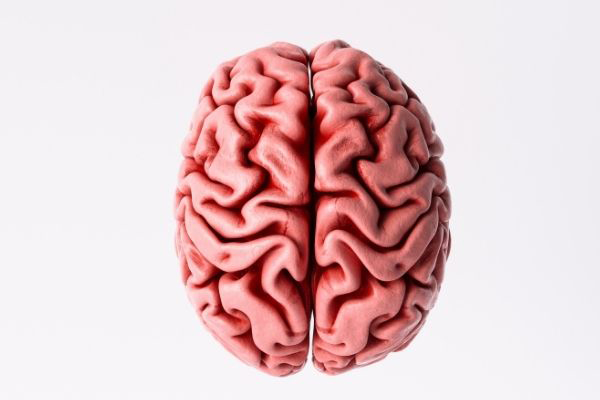
R is Recognize. What are the Four Characters? I got all these Four Characters in my brain. The better I get to know them, the easier it gets to recognize when they're alive and active in me. Who walked in the room with you, Sue? You got all four too. In any relationship between two people, there are eight of us and most of us are clearly aware of that. If you walk in as your Character 2 and I'm in my Character 1, I might realize, “Sue is unhappy and needs my attention.” I got to put down my busy, go into my Character 4, come over, scoop you up and say, “I'm right here. What do you need? Do you need me to hear you? Do you need to talk to me?” I consciously shift. R is Recognize. Who am I being? Who was I being before I called this BRAIN Huddle? Who's around me?
A stands for Appreciate that I have four to pick from. I've got all four and they're all available to me at any moment. The better I know them, the better I can jump into them. B is Breath and R is Recognize. Who called the BRAIN Huddle? Who was there? A is Appreciate that I have all four. I is Inquire in this next moment. It's like with that example. Sue came in and was unhappy as her Character 2. I'm inquiring, “Character 1 is inappropriate at this moment because Sue is okay. She doesn't have to fix anything.” In my Huddle, I'm inquiring, “Who should come out next?”
N stands for Navigate the next moment. At this moment, the next moment for me is I should jump into my Character 4, which is loving, open, supportive and come and be your friend and help you as you're in your Character 2. We connect instead of fixing, which is what Character 1 wants to do. Character 3 can come in and say, “Little Sue, can we go play? Do you want to go do this or that? Let's go do this.” You jump into your little Character 3 and say, “Thank you for loving me, being with me and supporting me. Let's go play.”
It's because Character 2 feels safer now.
What has happened at a neurological level is each of these are four different levels of consciousness that are vibrating in different frequencies with different vibes. We all know that. If you walk into a fight, you walk into a couple of Character 2’s going. First of all, two Character 2’s will never find a resolution. Somebody has got to step out of their Character 2 to find some resolution and peace. There's an energy. You can walk in and your Character 4 can pick up, “I walked into the middle of a fight. BRAIN Huddle, what do I do with this situation?”
Do I come in as a Character 1 and try to fix it? Do I come in as a Character 2, win that and keep it going? Do I come in with a playful Character 3 and try to bring a little inappropriate humor, which may or may not work? Do I open up to, “When you're ready, I'm going to play? Here I am.” Do I come in as that loving Character 4 and say, “I got you. I understand. I'm here. I'm with you. I'm wrapped around you. Whatever you need and when you're ready to step into something else, we're available.” We being my Character 4.
This is personal power. We have the power to choose moment by moment who and how we want to be in the world. That's how I ended that TED Talk. As you asked earlier, “What was the attraction of that TED Talk?” It was self-empowerment. We have the power to choose moment by moment who and how we want to be. I have had over 300,000 people write to me and say, “You had to have a stroke to figure that out. How do we do it with our brain?” My answer is the book, Whole Brain Living.
That's a ton of information. In the book, it's in great detail and you walk us through it. I would highly recommend every person to get it whether you're in therapy, a therapist or a lifelong learner that wants to keep up with the stuff. This is new, different and exciting. The coolest thing is we can nerd out on the cool stuff that we're learning about the hippocampus, the amygdala and stuff like that. It's both nerdy and practical.
Let's weave and own the power of what we are as human beings and evolve ourselves into conscious humanity so that we can feel like we're healthy.
I consider this book to be a roadmap to our peace of mind. Anybody who's got a brain, biologically speaking, we have these four modules of cells. They exhibit very specific skillsets. If you have a lesion, have a stroke or wipe them out, it becomes very predictable. We're pretty much wired similarly. Getting to know these by our character profiles makes so much sense. It's easy to see in ourselves and identify in our partners, children, parents, teachers and the school system. We're all on a hero's journey. We're born here.
In that whole hero's journey, the ultimate goal is to step out of the consciousness of the Character 1 left-brain thinking, which is of the rational world and relax enough to calm the little Character 2 so we can step into the true journey of learning, growth and ultimately connecting with our greatest part, which is Character 4. Consciousness is always available. That's where our piece is and that piece is the ultimate goal of all the hero's journeys. We have all of it. Let's weave and own the power of what we are as human beings and evolve ourselves into conscious humanity so that we can feel like we're healthy. This is about mental health and mental wellness.
As you were talking, I could feel myself get a little emotional. That's how much it's touching my heart. There's such a resonance. It's incredible. The book also has practical stuff. It has more about how to strengthen these different parts of neuroplasticity.
First of all, there are several myths in there that we're busting out. I want you to know who your Character 1 is and answer these questions. Where does it come out? How often does it come out? Who likes this part of you? Who runs from this part of you? All these details about your Character 1 gave it an identity because it has an identity. As soon as you name it and own it, you can differentiate.
It's like when you were born. Your brain didn't know you had two legs instead of one. You couldn't walk because you were a big ball of energy with parts flopping around. As soon as your brain figured out you had two legs that you could move independently, you gained the ability to have motility and mobility. That's exactly what we're doing with the brain. We're differentiating and refining our understanding of what is this beautiful thing inside of our head. It's just a bunch of cells.
As bringing it up to the level of symbolization, you're right. We can have meetings and stuff like that. I was having a little fantasy of you and me walking over to the Texas Legislature, giving an all-day workshop and teaching people to get to know these parts of themselves.
People come in with their Character 2 and they're angry, spewing venom, mean and all this. They're blaming and they're all ugly. We got so much of that going on in our society, even out in public. We have increased our ability to be the Character 2 out in society. Wouldn't it be great if instead of feeling, “Reject. Push away. There's a Character 2. It's mean, ugly and attacking,” to be able to instantaneously say in our Character 4, “That person needs love. That person needs to be heard, be listened to and be regulated back into their sanity.” We have the power to do that for one another. That's a different society.
That's an entirely different society. Even if we're not able to do that, we can have this regulation to navigate, go back to the brain and be able to navigate that.
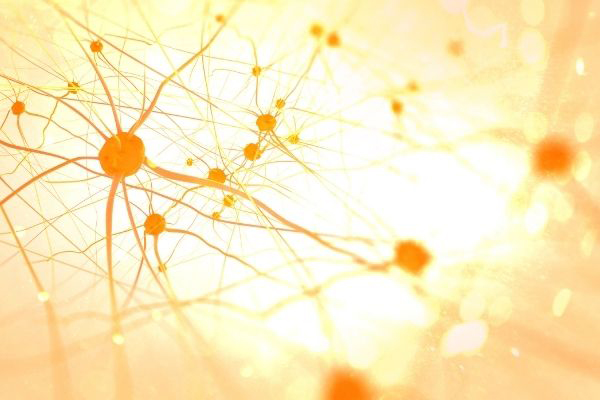
Whole Brain Living: We're differentiating and refining our understanding of these smart beautiful cells in our head.
Begin with the self or individual. For me, the goal is to help other people who are in pain because when we come out screaming, we're just screaming. There's no language and maturation there. There's desperation and deregulation. We need to be able to wrap ourselves around people's pain. Your pain does not scare me. The day I can walk up to you and say, “Your pain does not scare me. Please, when I'm in my pain, don't let my pain scare you. Surround me with love and we will get to the point where we can communicate and find true negotiation.”
I'm wondering what's next for you.
Absolutely. I'm more of a Character 4 that is going to wait and see what happens. What has happened is all of these people who are running not-for-profit and foundation organizations, doing yoga in prisons, AA rehabilitation and cancer with children or teaching Daoism and Whole Brain Living in China? They are coming to me and saying, “This is what I'm doing. How do I bring Whole Brain Living into my network?” I say to them, “What do you need from me? How do I support you?”
We're building this enormous neural network and I'm inviting everybody to the table for play. One of the other things that are magnificent is I'm working with a woman who is creating a research project. She's almost done with the proposal to the IRB to run a Whole Brain Living program in a school system. That is for the teachers, parents, children, principals and all the administration. She's doing some data collection to show that we can change the conscious culture of a school system. If we can do one, we can do it everywhere.
One of the things that the show could contribute is we have people all over the world. Some are practitioners and some are natural healers without letters behind their names, which we welcome with an open heart and learn from.
We'll have some Character 1 academics and some Character 4 wizards. I want them all.
Another thing that you're saying that's also a little different is it's not that we're aiming to stay in our Character 4. It's not that Character 1 is better. It is more of harmony.
It's all four. We have all four. As humanity, what we're doing is a stage of neuroanatomical evolution. We have this new thinking tissue on top of this old limbic stuff. The old limbic stuff is alarm alert in both hemispheres. We have this thinking tissue placed on top of that as humans, the neocortex. We're working the kinks out between the fibers of how we interact Character 1 with Character 2 in the left brain, Character 4 and Character 3 in the right brain, Character 1 and Character 4 through the corpus callosum, as well as Character 2 and Character 3 through the other commissures.
We are uniting our brains. The evolution of humanity is combining all these parts of the brain.
We are uniting our brains. The evolution of humanity is combining all these parts of the brain. I don't want just one. As a Character 4, I can tell you it's blissful, euphoric and fantastic but it is 100% ineffective and paralyzed. It can do nothing because there's no perception of self in relationship to the external world. I was completely ineffective as a Character 4. I am totally incompetent as a Character 1. I know my growth edge as a Character 2. I know when to push away and when to evaluate so I can head toward. With my playful Character 3, who doesn't want to play with Pigpen?
Is there any organizing principle that's happening that is not just little OU? I can imagine you being flooded. You said there were 300,000 contacts.
Bring it. We're at that stage where the book has been out since May 11th of 2021. People are reading it and they're reading it 3 or 4 times.
People are going to read this multiple times for sure.
The material is amazing because it's about not me. It's about you, me and us. Whoever you are, come. I'm creating a team to catch the balls. Everybody is starting to throw balls at me. I don't know what the balls are. I know what some of the balls are but we're navigating it as we go. DrJill@DrJillTaylor.com is my email. Bring it. How do I support you in what you're doing to bring this material to the world? We all have this beautiful brain and the faster we can communicate like this. I don't take it personally when you say something to me. It's like, “That was your little Character 2 who spit some venom at me. I love you despite yourself. Are you hungry? Are you tired? What do you need?”
I'm all about it. Here's another thing people could do right away. You've got the TED Talk that's amazing. The first one was My Stroke of Insight and the one we have been talking mostly about is Whole Brain Living. You can find that anywhere.
DrJillTaylor.com is my website. I have given over 100 podcasts. I'm planting seeds. What happens? It will grow organically. I'm here to catch as much of the balls as I can and I need to know what people need. Someone said, “I need one page for a leadership conference. I'm adding this Character 2 at the last minute. I need one sheet with the Four Characters at the top. What's going on in the BRAIN Huddle that I can include?” Let me know what people know. We will be posting things on the website that you need that you can use. I'm saying go to these beautiful brains. We want to help ourselves and others. This is a beautiful tool.
I'm resonating so much. I have a niece that was 24 years old when this happened. She had just graduated with her Aerospace Engineering degree. It's not what you think of when you think of a stroke victim or a doctor. She got hit with a stroke. It was super weird that it was at age 24. It's the same thing. This is a passionate space of losing part of your mind and bringing it back. Honestly, psychedelics is another thing. That's another subject but that that is some of why the results are so positive and strong.
The psychedelics are essentially quieting that left-brain attachment of me to self and me to the external and allowing me to have this magnificent experience of, “Without the circuitry, I am as big as the universe.” At the core of the universe is this intense feeling of love. When you come back from that, you're going, “This left brain is a tool. It's not who I am.” I want to live my life through the value structure of the collective whole because we got to fix that, connect with one another and heal this planet because without the planet, we don't have a life. Us healing one another is our mental health. We do have the power to grow up to be healthy humanity.
Honestly, even about climate, part of what happens with climate and the planet is that we either get overwhelmed that it's too scary or we dissociate and can't think of it. I love what you said earlier about, “I'm not afraid of your pain.” Part of what happened was you were freed of the fear of your pain. You were freed of it. If we could do something and create ripples of helping people not be afraid and be able to be regulated so that we can deal with the hard stuff like climate, it's very exciting.
Consider that in each of those four consciousnesses, the consciousness of Character 4 is the one that's always there. It's the consciousness in ourselves. If we want to heal ourselves, we need to get to that vibration and energy. I freaked out a bunch of people's left brains because, “She's doing woo-woo.” Woo-woo is real. There's woo-woo we label as woo-woo. There's woo-woo we reject because we don't understand it. Call it something else or the circuitry of your right brain.
Don't deny the existence of those abilities simply because of a bias because little Character 2 is saying, “That doesn't feel safe. We can't measure it. It doesn't work. Those people are weird. They're different from me.” That's just Character 2. Character 1 comes in and tells the stories, “It's all woo-woo. It's not real.” It's the anatomy of your brain. We have all of these capacities. Don't deny yourself the righteous ability to be a whole human being. Give yourself that gift in your lifetime. Why wouldn't we want to do that?
Speaking of gifts. I'm so excited. My brain is popping. I can see all kinds of fun things. This is Dr. Jill Bolte Taylor and the book, in particular, is Whole Brain Living. We highly recommend it. If it moves you, we have a reading group. Certainly, contact us. We have a Supercast community and you can find it at TherapistUncensored.Supercast.com. It's as low as $5 a month. You can have access to each other to do discussions and stuff like that. There's always an ability to pay. I'm happy to work with you around that. That's fine. We want it to be accessible and help you organize some of this stuff.
Also, Sue, I gave a one-hour webinar over three days. It was all the material. I was talking about the BRAIN Huddle because people have obstacles and it's like, “Let's get around those.” I do have a Facebook page but my team is posting all of these podcasts. We can do Whole Brain Living and mom rage, Whole Brain Living and sleep problems, Whole Brain Living and Buddhism and Whole Brain Living and all these different subjects. The beauty of the Whole Brain Living is it's all in there. It's applicable to every single subject there is for us as humanity.
The thing about it is it's very easy and quick to understand. What is hard is the application of it and what kind of support people need to do the Huddle. To me, that's where the juice is. How does this translate?
The BRAIN Huddle is the power. There's nothing like being able to sit back and say, “All that angst and hostility you're feeling, I'm sympathetic to you and I don't have to feel that.” Empathy doesn't mean I have to go bleed and sit in your blood. It means I can hold the space while you bleed and love you back to health.
Thank you for your generosity and we will stay in touch
—
Important Links:
- DrJillTaylor.com
- Whole Brain Living: The Anatomy of Choice and the Four Characters That Drive Our Life by Jill Bolte Taylor
- My stroke of insight – TED Talk
- My Stroke of Insight: A Brain Scientist's Personal Journey by Jill Bolte Taylor
- www.TherapistUncensored.com/join
- The Master and His Emissary: The Divided Brain and the Making of the Western World by Iain McGilchrist
- The Polyvagal Theory: Neurophysiological Foundations of Emotions, Attachment, Communication and Self-regulation by Stephen Porges
- BRAIN Huddle
- Andrew Newberg
- DrJill@DrJillTaylor.com
- TherapistUncensored.Supercast.com
- Dr. Jill Bolte Taylor – Facebook page
- https://www.nytimes.com/2008/05/26/health/26iht-25brain.13207332.html
About Dr. Jill Bolte Taylor
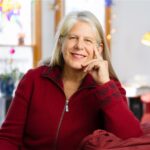 As a Harvard-trained neuroscientist, Dr. Jill Bolte Taylor has dedicated her life to understanding an
As a Harvard-trained neuroscientist, Dr. Jill Bolte Taylor has dedicated her life to understanding an
d sharing her knowledge on the power of neuroplasticity and how we can use it as a tool to heal our traumas and live a happier, more fulfilling life. After experiencing a severe hemorrhage at the age of 37, Dr. Bolte Taylor has a first-hand account of her recovery and findings through the difficult journey. From her famous TedTalk debut “My Stroke of Insight” to her memoir, she has inspired and educated millions through her public speaking and dedication to her field. Not only did her memoir earn a spot on the New York Times nonfiction bestseller list, but she continued on to release “Whole Brain Living: The Anatomy of Choice and the Four Characters that Drive Our Life” in May of 2021. This book combines psychology with neuroanatomy to share the four distinct modules and how we can use those cells to tap in and create an inner team to help guide us on the journey to a more peaceful life.

